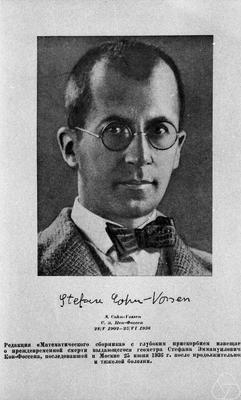Top Qs
Timeline
Chat
Perspective
Stefan Cohn-Vossen
Russian mathematician From Wikipedia, the free encyclopedia
Remove ads
Stefan Cohn-Vossen (28 May 1902 – 25 June 1936) was a mathematician, specializing in differential geometry. He is best known for his collaboration with David Hilbert on the 1932 book Anschauliche Geometrie, translated into English as Geometry and the Imagination.[1] Both Cohn-Vossen's inequality and the Cohn-Vossen transformation are named after him.[2] He also proved the first version of the splitting theorem.
Remove ads
Biography
Summarize
Perspective
Stefan Cohn-Vossen was born 28 May, 1902 to Emanuel Cohn, a lawyer, and Hedwig (née Vossen) in Breslau (then a city in the Kingdom of Prussia; now Wrocław in Poland). He attended Göttingen in 1920; his notes from Hilbert's lectures on geometry at that time would form the basis for Anschauliche Geometrie. He wrote a 1924 doctoral dissertation at the University of Breslau (now the University of Wrocław) under the supervision of Adolf Kneser.[3] In 1929 he completed his habilitation at Göttingen with his thesis Non-rigid closed surfaces[4] under Richard Courant.[5]
Cohn-Vossen became a professor at the University of Cologne in 1930.[6] In 1931, Cohn-Vossen married Dr. Margot Maria Elfriede Ranft. Anschauliche Geometrie was published in 1932; the book was well reviewed[7][8] and by association with Hilbert, Cohn-Vossen became well known.[9] He was barred from lecturing in 1933 under Nazi racial legislation, because he was Jewish.[10]
Unable to work in Germany, Cohn-Vossen moved to Switzerland in 1934, first to Locarno and then to Zurich, where he taught gymnasium. His son, Richard Cohn-Vossen, was born in Zurich in September 1934. Both Courant and Karl Löwner recommended Cohn-Vossen for positions abroad, at Istanbul and Dartmouth respectively; ultimately he emigrated to the USSR, with support from Herman Müntz, Fritz Houtermans, Pavel Alexandrov, and Heinz Hopf,[11] where he was appointed to the Academy of Sciences and worked at Leningrad State University and the Steklov Institute.[12][13]
Cohn-Vossen died in Moscow from pneumonia in 1936.[14] Despite his short time in the USSR, Cohn-Vossen had a significant impact on the development of differential geometry "in the large"[15] in Soviet mathematics.[16][17][18]
Following Cohn-Vossen's death, his widow, Dr. Elfriede Cohn-Vossen, remarried Alfred Kurella, returned to Germany in 1954, and died in 1957. His son, Richard, became a filmmaker. In 1946, unaware of his death, the University of Cologne offered Cohn-Vossen his professorship back.[19]
Remove ads
Publications
Books
- Hilbert, David; Cohn-Vossen, Stefan (1932). Anschauliche Geometrie [Geometry and the Imagination] (in German). Berlin: Springer.
- Cohn-Vossen, S. E. (Кон-Фоссен С. Э.) (1959). Некоторые вопросы дифференциальной геометрии в целом [Some Problems of Differential Geometry in the Large] (in Russian). Moscow: Fizmatgiz.
Articles
- Cohn-Vossen, Stephan (1927). "Singularitäten konvexer Flächen" [Singularities of convex surfaces]. Math. Ann. (in German). 97: 377–386. doi:10.1007/BF01447873.
- Cohn-Vossen, Stefan (1927). "Zwei Sätze über die Starrheit der Eiflachen" [Two theorems on the rigidity of the ellipsoid]. Nach. Gesellschaft Wiss. Gottingen, Math. Phys. Kl. (in German): 125–134.
- Cohn-Vossen, Stefan (1928). "Die parabolische Kurve. Beitrag zur Geometrie der Berührungstransformationen, der partiellen Differentialgleichung zweiter Ordnung und der Flächenverbiegung". Math. Ann. 99: 273–308. doi:10.1007/BF01459097.
- Cohn-Vossen, Stefan (1930). "Unstarre geschlossene Flächen" [Non-rigid closed surfaces]. Math. Ann. (in German). 102: 10–29. doi:10.1007/BF01782336.
- Cohn-Vossen, Stefan (1933). "Sur la courbure totale des surfaces ouvertes". C. R. Acad. Sci. Paris (in French). 197: 1165–1167.
- Cohn-Vossen, Stefan (1935). "Kürzeste Wege und Totalkrümmung auf Flächen" [Shortest paths and total curvature on surfaces]. Compositio Mathematica (in German). 2: 69–133.
- Cohn-Vossen, Stefan (1935). "Totalkrümmung und geodätische Linien auf einfachzusammenhängenden offenen vollständigen Flächenstücken" [Total curvature and geodesics on simply connected open patches]. Mat. Sbornik (in German). 43 (2): 139–164.
- Cohn-Vossen, Stefan (1936). "Der approximative Sinussatz für kleine Dreiecke auf krummen Flächen (Auszug aus einem Brief an Prof. T. Levi-Civita)" [The approximate sine rule for small triangles on curved surfaces]. Compositio Mathematica (in German). 3: 52–54.
- Cohn-Vossen, Stefan (1936). "Existenz kürzester Wege" [The existence of shortest paths]. Compositio Mathematica (in German). 3: 441–452.
- Cohn-Vossen, Stephan (1938). "Die Kollineationen desn-dimensionalen Raumes" [Collineations of n-dimensional space]. Math. Ann. (in German). 115: 80–86. doi:10.1007/BF01448928.
Remove ads
See also
References
External links
Wikiwand - on
Seamless Wikipedia browsing. On steroids.
Remove ads

